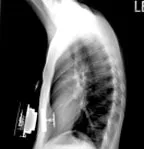Magnetic Mini-Mover
Procedure for pectus excavatum
Principal Investigator: Michael R. Harrison, MD
Challenge

Pectus excavatum is one of the most common major congenital anomalies, characterized by a deep depression of the sternum. For more than 50 years, pectus excavatum has been corrected by major surgical reconstruction through the use of either the Nuss or Ravitch procedures. Both of these procedures require major operations and hospitalization for pain management.
Solution
The Magnetic Mini-Mover Procedure (3MP) is a novel minimally invasive method of correcting pectus excavatum developed in an effort to make the pectus excavatum operation better for patients and their families. With this method the deformed costal cartilages are gradually reformed by a controlled gradual outward "pull" on the depressed breastbone. This is achieved with an outpatient surgical procedure and without the need for painful implanted chest wall struts. Two magnets, one implanted inside the chest and attached to the sternum and the second one outside the chest wall and attached to an external brace, are used together to create a magnetic force field which applies a controlled sustained pull.
Funding
National Institutes of Health SBIR
Publications
- Harrison MR, Gonzales KD, Bratton BJ, Christensen D, Curran PF, Fechter R, Hirose S. Magnetic mini-mover procedure for pectus excavatum III: safety and efficacy in a Food and Drug Administration-sponsored clinical trial. J Pediatr Surg. 2012 Jan;47(1):154-9.
Featured Media
Magnets May Pull Kids With Sunken Chests Out Of Operating Room - NPR - July 30, 2012
Kids With Chest Wall Deformities Get Comprehensive Care at Clinic - UCSF News - July 9, 2012
Magnets Tested as Alternative to Major Surgery for Sunken Chest - SF Gate - November 13, 2007
